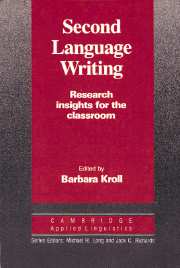Book contents
- Frontmatter
- Contents
- List of contributors
- Series editors' preface
- Preface
- Introduction
- I PHILOSOPHICAL UNDERPINNINGS OF SECOND LANGUAGE WRITING INSTRUCTION
- II CONSIDERATIONS FOR WRITING INSTRUCTION
- Chapter 7 Composing in English: effects of a first language on writing in English as a second language
- Chapter 8 The teaching of topical structure analysis as a revision strategy for ESL writers
- Chapter 9 What does time buy? ESL student performance on home versus class compositions
- Chapter 10 Feedback on compositions: teacher and student verbal reports
- Chapter 11 Teacher response to student writing: focus on form versus content
- Chapter 12 Responding to different topic types: a quantitative analysis from a contrastive rhetoric perspective
- Chapter 13 Writing with others' words: using background reading text in academic compositions
- Index
Chapter 12 - Responding to different topic types: a quantitative analysis from a contrastive rhetoric perspective
Published online by Cambridge University Press: 05 October 2012
- Frontmatter
- Contents
- List of contributors
- Series editors' preface
- Preface
- Introduction
- I PHILOSOPHICAL UNDERPINNINGS OF SECOND LANGUAGE WRITING INSTRUCTION
- II CONSIDERATIONS FOR WRITING INSTRUCTION
- Chapter 7 Composing in English: effects of a first language on writing in English as a second language
- Chapter 8 The teaching of topical structure analysis as a revision strategy for ESL writers
- Chapter 9 What does time buy? ESL student performance on home versus class compositions
- Chapter 10 Feedback on compositions: teacher and student verbal reports
- Chapter 11 Teacher response to student writing: focus on form versus content
- Chapter 12 Responding to different topic types: a quantitative analysis from a contrastive rhetoric perspective
- Chapter 13 Writing with others' words: using background reading text in academic compositions
- Index
Summary
There are many reasons to assess writing: student placement in composition classes, program evaluation, instructional design needs, individual diagnosis and progress, evaluation of exit competencies, and mastery of course content. And, as Hamp-Lyons demonstrates in this volume, there are many factors involved in the design, implementation, and evaluation of writing tasks. This chapter is concerned with a limited area in writing assessment: the evaluation of second language writing skills through a 30-minute writing task. In particular, it examines what Ruth and Murphy (1988) call a “neglected variable” in writing assessment research: the impact of the topic task on the writers' responses in the assessment process. In addition, the study uses data from prior studies in contrastive rhetoric – the study of the hypothesis that different languages have different rhetorical preferences in textual organization, preferences reflected in syntactic and other textual differences (Grabe and Kaplan 1989) – to investigate and interpret differences between and among native speakers of four language backgrounds – Arabic, Chinese, Spanish, and English – writing in English. The present study uses a discourse analysis approach to identify the quantitative differences in the syntax and lexicon in a total of 768 responses to four writing assessment tasks, consisting of two topic types and two topic tasks of each type. Data from this study demonstrate that, at least quantitatively, different topic tasks administered to writers with different language and cultural backgrounds elicit responses that are linguistically measurable and measurably different.
- Type
- Chapter
- Information
- Second Language Writing (Cambridge Applied Linguistics)Research Insights for the Classroom, pp. 191 - 210Publisher: Cambridge University PressPrint publication year: 1990
- 28
- Cited by



